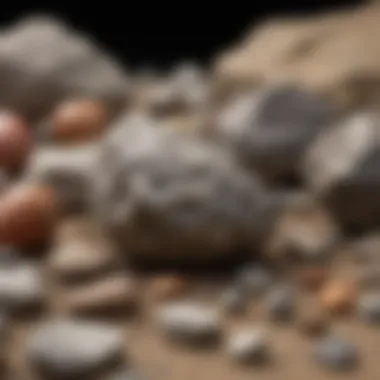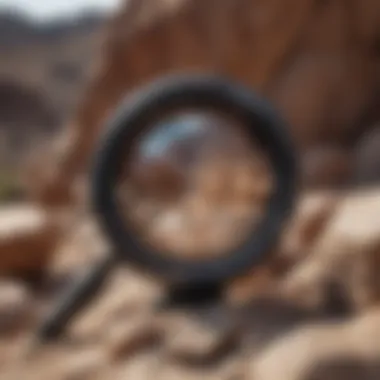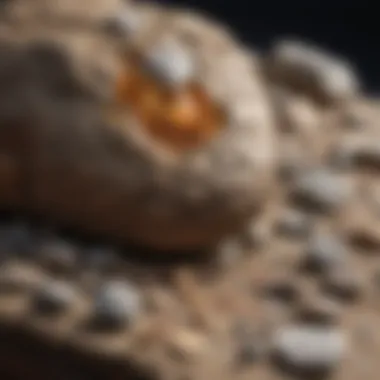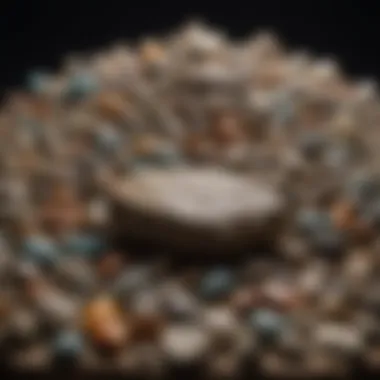Rock Collector's Kit: Your Ultimate Guide to Enhance Your Collection


Rock and Fossil Identification
Being a rock and fossil enthusiast is an exhilarating journey, delving into the intricate world of geological wonders from eons past. Identifying different types of rocks and fossils is a fundamental skill that forms the bedrock of your collection. Whether you are drawn to igneous, sedimentary, or metamorphic rocks, each specimen holds a unique story etched in time. To kickstart your collection, familiarize yourself with the distinct characteristics to look for in rocks and fossils. Keep an eye out for texture, color, density, and any unique patterns that may indicate the specimen's origin and composition. Equipping yourself with the right tools for identification is essential - a sturdy rock hammer, chisels, magnifying glass, and a trusty field guide are invaluable companions on your exploration of rock formations.
Collecting Tips and Techniques
Embark on your collecting journey armed with time-honored best practices to elevate your craft. Successful rock and fossil collecting begins with meticulous planning and research. Explore reputable sources to pinpoint prime collecting sites, where geological treasures await discovery. Once you've identified your target location, exercise caution and prioritize safety when extracting specimens. Delicate tools like brushes and dental picks can aid in gentle excavation without damaging the integrity of the rock or fossil. Remember, patience is key - the perfect specimen may be hidden beneath layers of sediment, waiting to be unearthed.
Preservation and Display
Preserving your rock and fossil collection is essential to conserve their beauty and integrity for generations to come. Implementing proper preservation techniques helps maintain the specimens' structural stability and prevents degradation over time. Consider methods such as wrapping fossils in acid-free paper to prevent contact corrosion or using archival boxes for long-term storage. When it comes to displaying your collection, let your creativity shine. Showcase your prized pieces in shadow boxes, under soft lighting to accentuate their intricate details. Experiment with different arrangements to create visually captivating displays that showcase the diversity and charm of your geological finds.
Geological Insights
Dive into the captivating world of geological formations and processes, unraveling the mysteries of our planet's history. Explore the significance of rock and fossils beyond aesthetic appeal, delving into their roles in shaping Earth's landscapes. Unearth the historical importance of rocks and fossils, from ancient marine fossils hinting at past ecosystems to volcanic rocks preserving moments of fiery eruptions. Immerse yourself in notable discoveries that have reshaped our understanding of Earth's evolution, uncovering fossilized remains of prehistoric creatures or rare minerals that provide glimpses into geological phenomena. Each discovery offers a profound insight into the intricate tapestry of our planet's past, inviting you to uncover more hidden gems awaiting exploration.
Introduction
Delving into the introductory segment of this guide, we are met with a plethora of elements that pave the way for a remarkable expedition into the world of rocks and fossils. This section acts as a compass, pointing readers towards essential tools, advanced techniques, and critical considerations that will nurture their fascination and deepen their appreciation for geological wonders.
Embracing the essence of the introduction, we find ourselves drawn to the foundational aspects that underpin the art of rock and fossil collection. From igniting curiosity to fostering a sense of exploration, the introduction sets the stage for a transformative experience where individuals can unlock the mysteries held within the Earth's rocky embrace.
As we embark on this odyssey through the intricacies of rock and fossil collecting, the introduction stands as a beacon, illuminating the path towards a nuanced understanding of not just the physical specimens themselves but the captivating narratives they carry within their mineral veins and fossilized remains. Through a meticulous exploration of this foundational section, readers will be equipped with the knowledge, inspiration, and motivation needed to delve deeper into the realms of geology and paleontology.
Understanding the Basics
The foundation of any pursuit lies in understanding its fundamental principles, and rock collecting is no exception. In this section, we delve into the importance of grasping the basics, as they form the bedrock (pun unintended) of your entire collection journey. By comprehending the core concepts, enthusiasts can sharpen their eye for quality rocks and fossils, potentially avoiding rookie mistakes and honing their expertise efficiently. Understanding the basics sets the stage for a successful and gratifying venture into the world of geological wonders.
What is a Rock Collector's Kit?
When embarking on the captivating hobby of rock and fossil collecting, having the right tools at hand is essential. A rock collector's kit is a curated set of instruments designed to aid enthusiasts in their exploration and extraction endeavors. From rock hammers to chisels, safety goggles, brushes, and containers, this kit equips collectors with the essentials needed to unearth and preserve their geological treasures.
Tools of the Trade
Rock Hammer
The rock hammer stands as a stalwart companion in any collector's toolkit, boasting a sturdy handle and a hardened head that can withstand the rigors of rock breaking. Its balanced design allows for precise strikes, essential for extracting specimens without causing excessive damage. While its weight may vary, a quality rock hammer is characterized by its durability and ergonomic grip, making it a popular choice among enthusiasts for its reliability.


Chisel
A chisel serves as a fine surgical tool in the hands of a rock collector, enabling precise splitting and detailed excavation work. The sharp edge of the chisel, combined with a steady hand, allows for intricate fossil extraction and delicate shaping of rocks. Its versatility in handling various rock compositions makes the chisel a valuable asset in the search for unique specimens.
Safety Goggles
Ensuring personal safety is paramount in any collecting expedition, and safety goggles play a crucial role in safeguarding against potential hazards. These goggles shield the eyes from flying rock fragments, dust, and debris, reducing the risk of accidents or injuries during excavation. Lightweight and impact-resistant, safety goggles provide clear vision while offering essential protection to collectors.
Brushes
Precision in cleaning and detailing rocks and fossils is made possible by the gentle touch of brushes in a collector's arsenal. Soft-bristled brushes aid in removing dirt, dust, and sediments without compromising the integrity of delicate specimens. Their varied sizes and shapes cater to different cleaning needs, facilitating meticulous preservation practices in rock and fossil maintenance.
Containers
A collector's kit is incomplete without suitable containers to store and transport precious finds. Containers come in various sizes and materials, providing secure housing for rocks and fossils during fieldwork and display. From sturdy plastic boxes to padded cases, choosing the right container ensures the safety and organization of a collector's expanding collection.
Essential Safety Precautions
Prioritizing safety precautions is non-negotiable in the world of rock and fossil collecting. Enthusiasts must be aware of potential risks involved in excavation, handling, and storage, mitigating hazards through proactive measures. From wearing protective gear to maintaining a cautious approach, implementing essential safety precautions fosters a secure and enjoyable collecting experience.
Building Your Collection
Building your rock and fossil collection is a fundamental aspect for any enthusiast aspiring to delve into the fascinating world of geological wonders. By meticulously selecting rocks and fossils, you not only expand your collection but also deepen your understanding of different geological formations and their significance. The process of building your collection involves careful consideration of various factors such as rock types, locations, and fossil preservation techniques. Each addition to your collection tells a unique story of our planet's rich history and evolution, making it a truly enriching and educational pursuit.
Choosing the Right Rocks
Identification
Identification of rocks and fossils is a crucial skill for any collector. It involves recognizing key features such as color, texture, and composition to classify specimens accurately. By honing your identification skills, you can differentiate between different rock types and understand their formation processes better. This ability not only aids in building a diverse collection but also enhances your overall expertise in geology.
Hunting Locations
Exploring suitable hunting locations is essential for rock and fossil collectors. Choosing the right locations can significantly impact the quality and variety of specimens you find. Whether it's searching along rocky beaches for unique rock formations or venturing into quarries in search of fossils, selecting the ideal hunting spots can make all the difference in your collection. Each location offers a distinct geological perspective, enriching your collecting experience.
Fossil Hunting Tips
Researching Fossil Sites


Conducting thorough research on fossil sites is paramount for successful fossil hunting. By studying geological maps, examining soil compositions, and understanding the history of the area, you can pinpoint potential fossil-rich locations. This knowledge not only increases your chances of finding valuable specimens but also allows you to appreciate the geological context of your discoveries.
Tools for Fossil Hunting
Having the right tools is essential for effective fossil hunting. Tools such as rock hammers, brushes, and chisels help you extract fossils delicately without damaging them. Each tool serves a specific purpose, from uncovering delicate fossils to cleaning intricate details. By equipping yourself with the appropriate gear, you can ensure a successful and rewarding fossil hunting expedition.
Cleaning and Preserving Your Finds
Techniques for Cleaning Rocks
Employing proper techniques for cleaning rocks is crucial for maintaining the integrity of your specimens. Techniques like brushing, air scribing, and chemical cleaning can help remove dirt and debris without harming the rocks. By mastering these cleaning methods, you can reveal the true beauty of your finds while preserving them for years to come.
Preservation Methods
Preserving fossils is essential to protect them from deterioration and damage. Methods such as casting, moulding, and stabilizing fragile fossils ensure their longevity and scientific value. Implementing preservation techniques safeguards your specimens for future study and display, allowing you to share the wonders of geology with enthusiasts and researchers alike.
Advanced Techniques and Strategies
In the realm of rock and fossil collecting, the significance of advanced techniques and strategies cannot be overstated. It serves as a gateway to unraveling the mysteries hidden within rocks and minerals. By delving into advanced methods, enthusiasts can elevate their understanding of geological formations and unearth rare specimens. Advanced techniques enable collectors to conduct intricate analyses, identify unique properties, and distinguish between various minerals with precision. These strategies not only enhance the quality of one's collection but also contribute to a deeper appreciation of the Earth's geological history. Engaging with advanced techniques empowers enthusiasts to expand their knowledge and explore the complexities of rock and fossil identification with a discerning eye.
Rock and Mineral Identification
Using Field Guides
Exploring the art of using field guides in rock and mineral identification is an essential aspect of a collector's journey. Field guides offer a comprehensive catalog of geological specimens, aiding in accurate identification and classification. Their detailed descriptions and visual references simplify the process of recognition, making them invaluable tools for enthusiasts. By leveraging field guides, collectors can streamline their identification processes, compare specimens with illustrated examples, and learn about the unique characteristics of different rocks. Despite their utility, using field guides may pose challenges such as misinterpretation of features or difficulty in matching specimens to the illustrations. However, the benefits of utilizing field guides in this article are undeniable, as they serve as educational companions that enrich one's understanding of rocks and minerals.
Identification Challenges
Navigating through identification challenges adds a layer of complexity and intrigue to the rock and mineral collecting experience. These hurdles prompt enthusiasts to hone their observation skills, conduct thorough research, and seek expert guidance to overcome them successfully. Identification challenges compel collectors to think critically, utilize various resources, and engage in detailed examinations to decipher the unique attributes of different specimens. While these challenges may test one's patience and expertise, they foster growth and learning opportunities, leading to a more profound knowledge of geological diversity. The process of overcoming identification challenges in this article not only sharpens an enthusiast's skills but also cultivates resilience and perseverance in the pursuit of expanding their collection.
Lapidary Arts
Cutting and Polishing Techniques
Delving into the realm of cutting and polishing techniques elevates a collector's interaction with rocks and minerals to an artistic level. The meticulous process of cutting gems and polishing stones involves precision, patience, and creativity. These techniques allow enthusiasts to transform rough specimens into exquisite gems, revealing the hidden beauty within. By mastering cutting and polishing methods, collectors can customize their specimens, create unique shapes, and enhance their visual appeal. While these techniques require skill and practice, the result is a stunning display of nature's artistry captured within each polished creation. Embracing cutting and polishing techniques in this article unlocks a world of artistic expression and craftsmanship that complements the scientific pursuit of rock and mineral collecting.
Creating Jewelry


Exploring the art of creating jewelry from rocks and minerals seamlessly merges geology with fashion, offering collectors a creative outlet for their discoveries. Designing jewelry pieces with unique stones involves a harmonious blend of aesthetics and geological knowledge. Creating jewelry allows enthusiasts to showcase their prized specimens in wearable art forms, infusing personal style and meaning into each piece. The process of crafting jewelry from rocks and minerals in this article encourages collectors to experiment with design, embrace authenticity, and share their passion for geological treasures with others. While creating jewelry may require attention to detail and craftsmanship, the end result is a reflection of nature's splendor transformed into exquisite adornments that can be cherished for generations.
Trading and Networking
Joining Rock Clubs
Engaging with rock clubs opens doors to a vibrant community of collectors, enthusiasts, and experts who share a common passion for rocks and minerals. Joining rock clubs provides opportunities for knowledge exchange, field exploration, and mutual support among members. The camaraderie within rock clubs fosters a sense of belonging and camaraderie, creating a supportive environment for enthusiasts to collaborate, learn, and grow together. By joining rock clubs in this article, collectors can expand their social network, participate in group activities, and access valuable resources and knowledge shared within the community.
Online Trading Platforms
Exploring online trading platforms revolutionizes the way collectors buy, sell, and exchange rocks and minerals in a digital landscape. These platforms offer a convenient space for enthusiasts to showcase their collections, connect with buyers or traders worldwide, and engage in virtual transactions. Online trading platforms provide a broader marketplace for collectors to explore rare specimens, negotiate deals, and expand their collection without geographic limitations. While leveraging online trading platforms in this article may involve navigating through online transactions and ensuring secure exchanges, the access to a vast network of collectors and sellers opens up a world of possibilities for enthusiasts seeking to diversify their collection or engage in trading activities.
Storage and Display
In the intricate world of rock and fossil collecting, the segment focused on Storage and Display plays a pivotal role in this comprehensive guide. Storage and Display directives are crucial for any enthusiast as they determine the longevity and aesthetic value of the collection. While amassing rocks and fossils is undoubtedly thrilling, appropriate storage ensures their preservation for generations to come. Moreover, an appealing display not only showcases your treasures but also serves as a source of pride and inspiration for fellow collectors. The overarching goal of this section is to enlighten enthusiasts on the significance of organizing and presenting their collections in an efficient and visually pleasing manner.
Organizing Your Collection
Storage Solutions
Within the realm of rock and fossil collecting, the selection of suitable storage solutions becomes a pivotal aspect. An apt storage system not only safeguards the integrity of the specimens but also ensures ease of accessibility for study and admiration. Many collectors opt for custom-built cabinets with compartments designed to accommodate various rock sizes and shapes. Acrylic display cases are another popular choice, offering transparency and protection simultaneously. The element of durability is a key characteristic that defines efficient storage solutions, as it guarantees the preservation of delicate fossils and rocks against environmental factors. While certain storage solutions may require a significant investment, their versatile and long-lasting nature makes them a prudent choice for dedicated collectors. Overall, the meticulous selection of storage solutions significantly enhances the overall appeal and maintenance of a fossil and rock collection. Despite the prevalence of digital cataloging options, physical storage solutions continue to hold their ground due to their tangible and experiential significance.
Labeling and Cataloging
The practice of labeling and cataloging items within a rock and fossil collection serves as a fundamental organizational tool and contributes immensely to the efficiency of retrieval and research. Imparting vital information such as the location and date of acquisition on each specimen ensures a well-documented collection, aiding in accurate historical interpretations. Labeling materials vary from acid-free paper tags to specialized labeling equipment for durable inscriptions. A key characteristic of effective labeling and cataloging lies in the clarity and accuracy of information conveyed, facilitating seamless tracking of specimens. The unique feature of meticulous labeling and cataloging lies in its ability to transform a mere collection into a well-curated archive, promoting not just visual appeal but also scholarly pursuits within the collectors’ community. While the digital era presents innovative cataloging software, traditional labeling methods remain a timeless choice for enthusiasts seeking a personalized and tangible connection with their artifacts.
Creating Aesthetic Displays
Display Cases
When it comes to enhancing the visual appeal of a rock and fossil collection, the role of display cases cannot be overstated. Display cases offer a protective yet transparent shield, allowing viewers to admire the specimens from multiple angles while safeguarding them from dust and mishandling. A key characteristic of quality display cases is their capacity to provide adequate ventilation and lighting, ensuring optimal visibility without compromising the artifacts’ preservation. The unique feature of display cases lies in their ability to transform a simple gathering of rocks into an immersive and educational exhibit, captivating audiences and fostering a deeper appreciation for geological wonders. While variations in display cases exist—ranging from wall-mounted to countertop options—their advantages uniformly extend to elevating the overall presentation of rock and fossil collections, making them an indispensable asset for serious collectors.
Arrangement Tips
The art of arranging rocks and fossils within a display setting is akin to creating a captivating story where each specimen plays a distinct role. Arrangement tips serve as guidelines to harmonize colors, shapes, and sizes, creating visually engaging compositions that spark curiosity and admiration. A key characteristic of effective arrangement lies in establishing a thematic or chronological narrative within the display, allowing viewers to appreciate the evolutionary journey of these geological treasures. The unique feature of adept arrangement tips is their transformative effect, turning a mere collection into a harmonious symphony of natural artistry. While arranging rocks and fossils may seem subjective, adhering to fundamental design principles enhances the overall cohesion and impact of the display. In essence, arrangement tips empower collectors to curate displays that not only dazzle the eyes but also unravel the enthralling tales of Earth’s geological past with finesse and elegance.
Conclusion
Rock and fossil collecting is not merely a hobby; it is a passion that connects enthusiasts to the Earth's history and beauty. This concluding section encapsulates the essence of the entire article, emphasizing the critical role of reflection and conservation in a collector's journey. As individuals delve into the realm of rock and fossil collection, they not only accumulate geological wonders but also foster a deep appreciation for the intricate processes that have shaped our planet over millennia.
In the context of this guide, the Conclusion serves as a pivotal moment for collectors to pause and contemplate the significance of their pursuit. It prompts them to consider the broader implications of their actions, urging responsible practices to ensure the preservation of natural landscapes and historical artifacts for future generations.
Moreover, the Conclusion extends beyond mere acknowledgment of collecting techniques; it delves into the ethics of fossil hunting and the importance of respecting geological sites. By highlighting the delicate balance between exploration and conservation, this section encourages enthusiasts to approach their hobby with a sustainable mindset, recognizing the finite nature of Earth's resources.
Lastly, the Conclusion reaffirms the transformative power of rock and fossil collecting, not just as a pastime but as a means of fostering a deeper connection to the natural world. It underscores the emotional and intellectual rewards that come from immersing oneself in the study of rocks and fossils, enriching not only one's collection but also one's understanding of Earth's geological tapestry.







